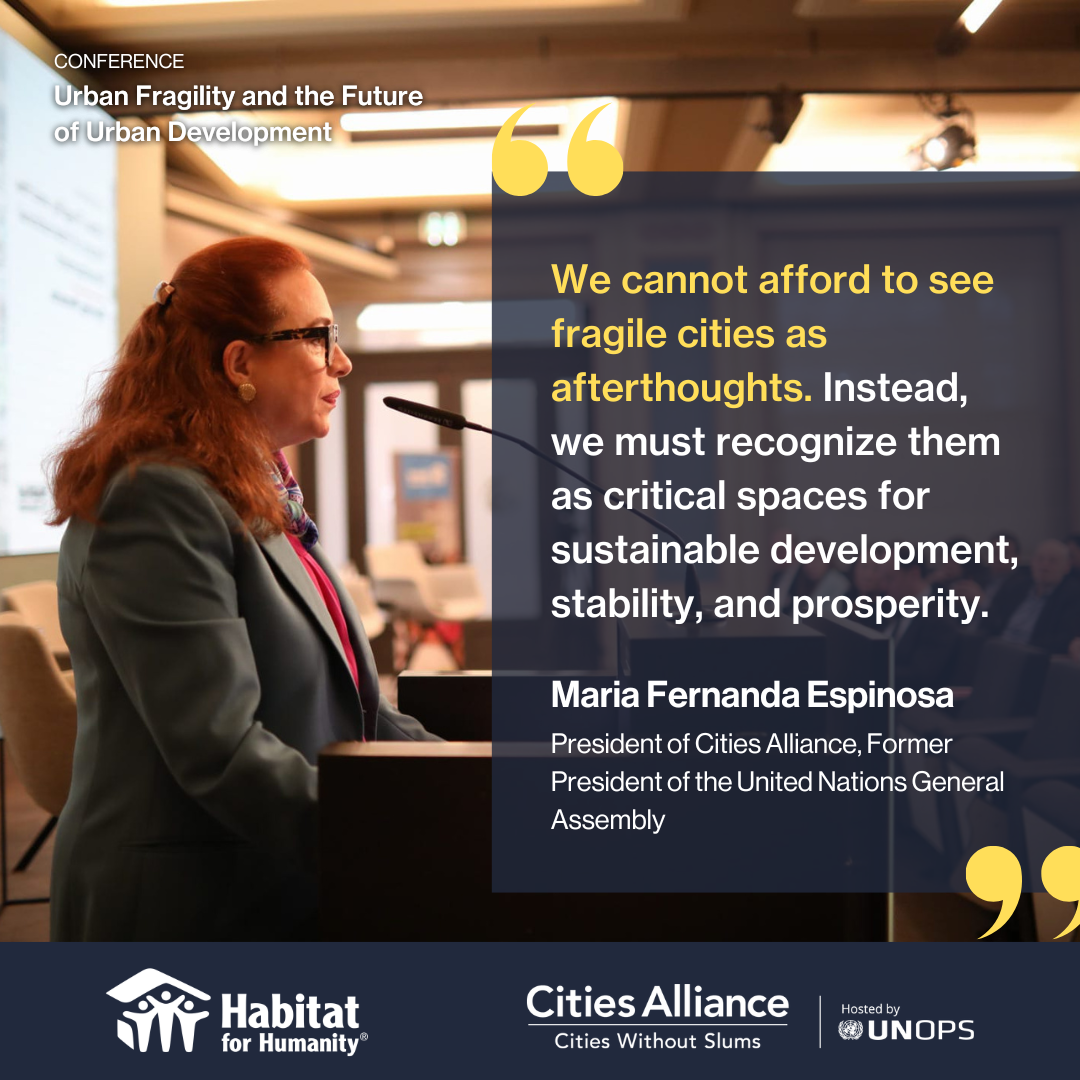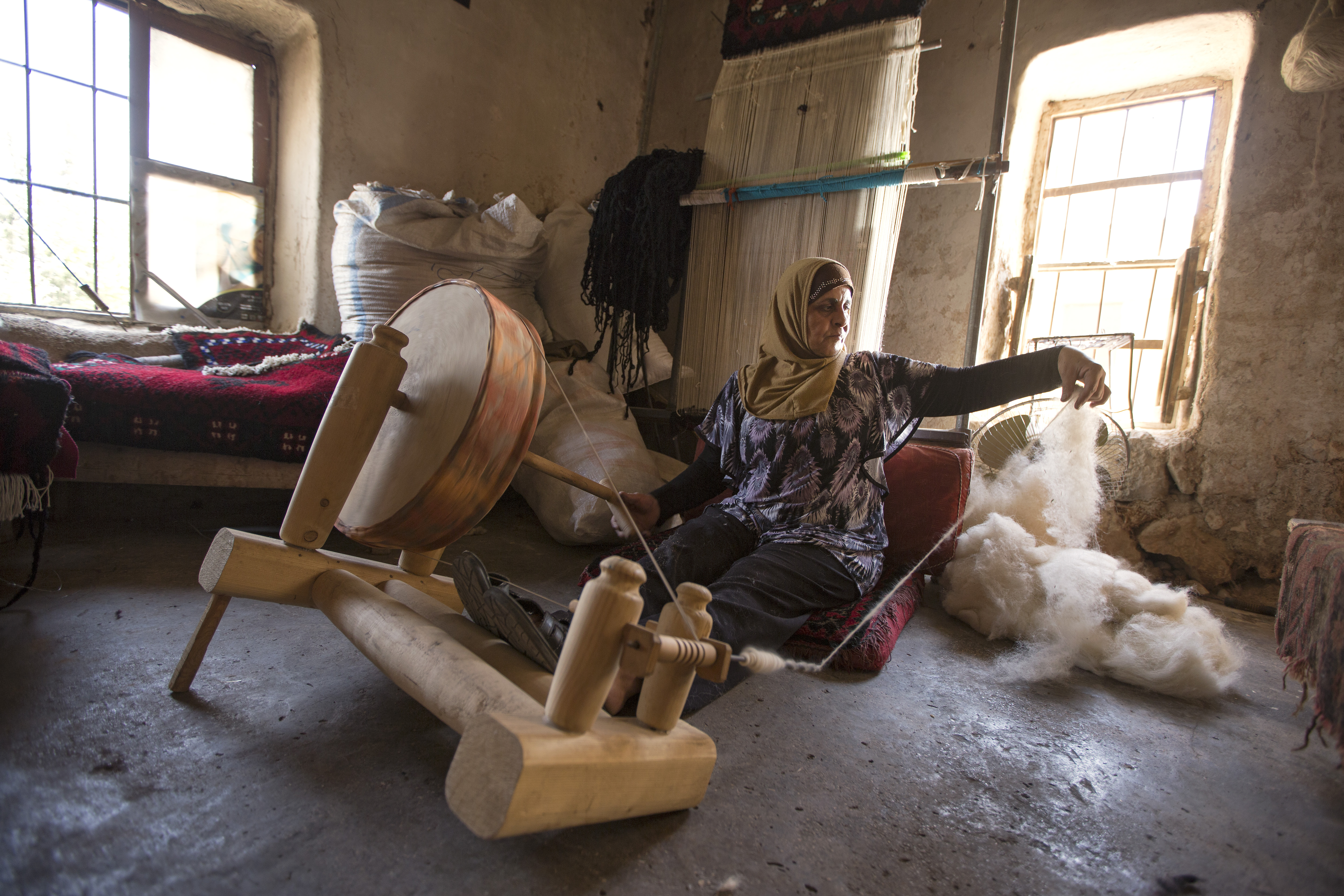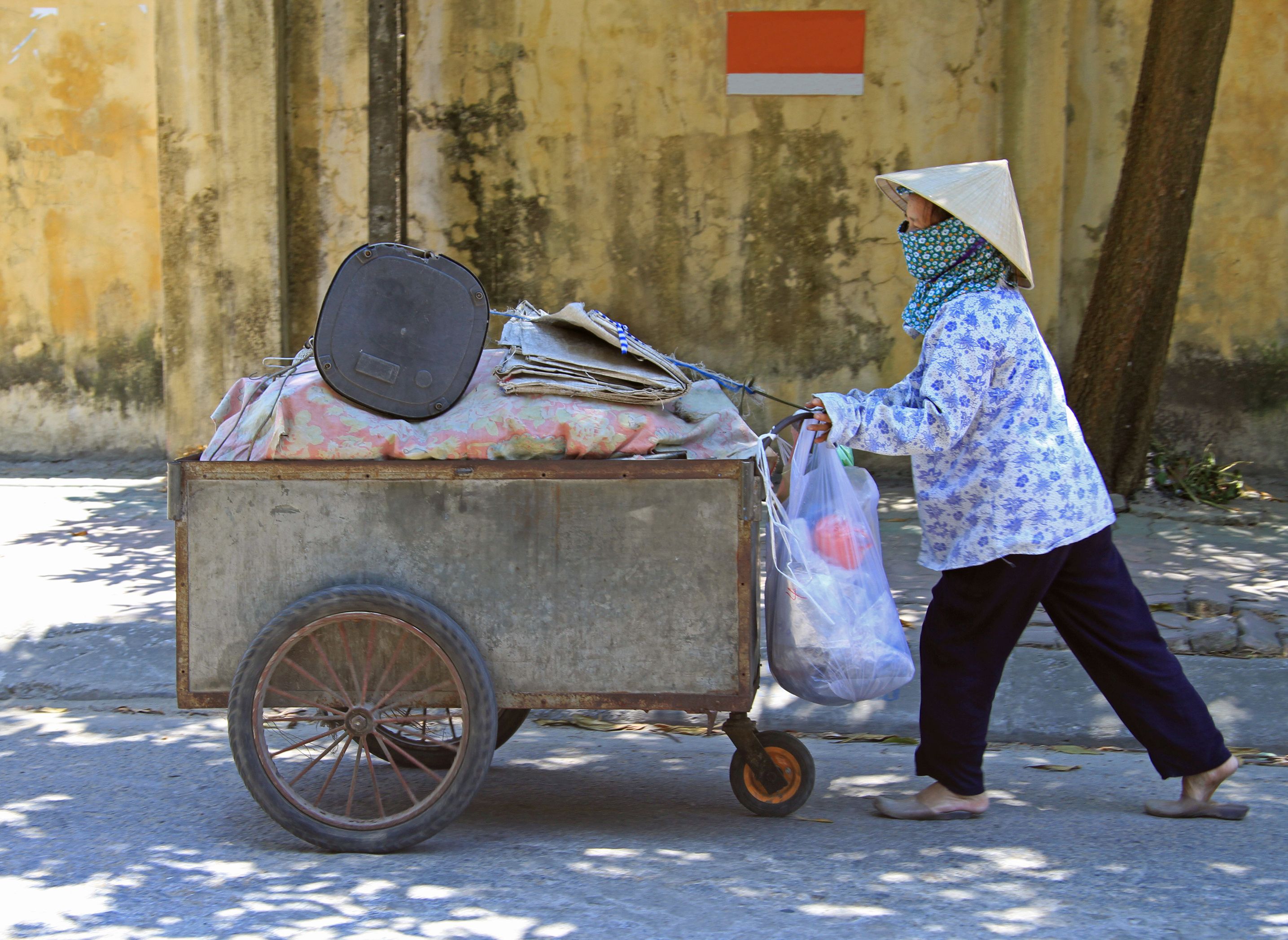Urban fragility has emerged as a critical global challenge, demanding urgent attention and strategic investments. This was the resounding message the Urban Fragility and the Future of International Development conference in Brussels on 4 February 2025.
Co-organized by Cities Alliance and Habitat for Humanity International, the event brought together nearly 200 participants to explore how targeted interventions in fragile urban areas can drive long-term development and bolster stability worldwide.
The conference underlined the growing urgency of addressing urban fragility, particularly in the Global South. With 70 percent of the world's population projected to reside in cities within the next two decades, urban centres have become the frontlines of today’s biggest challenges including conflict, climate change impacts, economic shocks, and displacement.
"We need to address urban fragility in a systemic, interconnected way," said Maria Fernanda Espinosa, President of Cities Alliance, opening the event. "We've seen recent suspensions of international aid deepening vulnerabilities globally.” With declining Official Development Assistance (ODA), geopolitical tensions, and a weakening multilateral architecture, cities are key to addressing fragility. “We need to shift the way we approach fragile urban areas, not as problems to be contained, but as critical investment opportunities for long-term development and stability”, she said.
Towards an EU integrated approach to fragility
In her keynote address, Erica Gerretsen, Director of Human Development, Migration, Governance and Peace at the European Commission DG-INTPA, further emphasised the complex and multilayered nature of urban fragility and the rise of migration and displacement as a consequence. She highlighted how the root causes of fragility—economic downturns, political instability, climate change, and social inequalities—drive people to seek opportunities and safety in cities.

Urban fragility is an increasing challenge. If left unaddressed, the pressure on urban areas threaten to destabilize local economies and communities.
Erica Gerretsen, Director Human Development, Migration, Governance and Peace, DG INTPA, European Commission
Gerretsen stressed that these converging crises require a new approach to international cooperation. She highlighted the EU's commitment to applying the Humanitarian-Development-Peace (HDP) nexus approach, ensuring that immediate needs are met while fostering long-term stability and resilience. She called for direct funding for local authorities, partnerships with civil society and leveraging initiatives such as the EU’s Global Gateway to bolster connectivity, infrastructure, and essential services in vulnerable urban settings.
The conference featured three sessions, each focusing on a critical aspect of urban fragility and international development cooperation:

This panel discussion, moderated by Dora Meredith, Director of ODI Europe, explored how strategic investments in infrastructure, governance, and basic services can strengthen the social fabric and the central role of cities in fostering sustainable development and global stability.
A key insight was the critical need for development cooperation to prioritize long-term resilience in vulnerable urban areas through proactive investments and sustained support to local authorities and structures. Julia Iversen, Director of GIZ’ Urban Development Centre emphasized the importance of engaging local leaders, stating "We need to integrate the mayors in these conversations because these interventions happen in cities."
Panellists also stressed the need for European and international actors to remain engaged, given the interconnectedness of global crises and the direct impact investments in fragile urban contexts have on global peace and stability.
"Proactively investing in resilience not only strengthens cities but reduces the cost of future crises”, said Jean Van Wetter, CEO of the Belgian Cooperation Agency— Enabel. He stressed that todays’ challenges require collective approaches and can only be solved through development cooperation. “It is an investment in our common world and our common interest”.
The panel also underlined trust-building with local communities, along with small-scale infrastructure and adequate housing, as essential foundations for strengthening social cohesion in fragile urban areas.
Building trust has to be one of the fundamental steps to addressing fragility.
Greg Munro, Director, Cities Alliance
The discussion concluded by highlighting the economic potential of informal settlements. Jonathan Reckford, CEO of Habitat for Humanity International, noted, "We tend to think about big infrastructure, but small interventions can make an enormous impact. Housing is, in many ways, the foundation for addressing broader challenges in urban settings."

This technical session, moderated by Mounia Tagma, Housing Policy Expert, explored the complex interplay of multilateral and private sector funding in fostering long-term resilience in fragile cities. The discussion addressed the impact of diminishing ODA and strategies for navigating the complexities of working in fragile environments.
Judy Baker, Cities Alliance’s Senior Urban Advisor, warned of the consequences of the current US foreign aid freeze. "Unpredictability is awful for development," she said, emphasizing the detrimental effect on both short-term humanitarian aid and long-term development programmes, especially in fragile contexts such as DRC, Sudan, and Somalia.
This implies potential increases in instability when assistance dwindles, underscoring the need for other actors, particularly the private sector, to fill the gap.
"The private sector plays a key role as an enabler to find the right business models”, said Cédric de Meeûs, Vice President of Group Public Affairs and Social Impact at Holcim. “It is not about philanthropy, but about responding to the needs of people in fragile settings by leveraging technical expertise and resources.” This requires two crucial elements, multistakeholder partnerships and community engagement.
“Working in fragile contexts needs strong collaboration with a variety of actors, including INGOs, NGOs, local governments, and critically, communities themselves. There is no project that can work without local bottom-up engagement", said de Meeûs. He stressed the need to understand community experiences, expectations, and abilities to ensure that projects are tailored to actual needs and that the local population accepts and takes ownership of private sector-supported initiatives.
This focus on ‘4Ps’—people-public-private partnerships—aligns with the European Commission's Global Gateway strategy, which aims to strengthen global connections through sustainable infrastructure globally.
The private sector is the centre of gravity of the Global Gateway
Sergio Oliete Josa, Head of Unit, Sustainable Transport and Urban Development, DG INTPA, European Commission
Sergio Oliete Josa of DG INTPA draw attention to the initiative's focus on developing private sector networks, from small businesses to large investments, across various sectors including digital, water supply, construction, and housing. He also acknowledged the challenge of investing in the upgrading of informal settlements: "Investing in slums is the investment with the highest economic return in terms of wellbeing, health, economic growth, yet it is difficult to have a business case.”
This challenge reveals the need for risk mitigation strategies to incentivize private sector involvement and flexible funding mechanisms—ones that can adapt to the unpredictable nature of fragile contexts.
From Fragility to Resilience: Community-Driven Solutions for Lasting Urban Change

This roundtable discussion, moderated by Dyfed Aubrey, Head of Brussels Office, UN-Habitat, brought together urban practitioners to reflect on the power of community-based initiatives to cope in crises, foster resilience, and drive urban transformation.
The session began with a powerful personal account from Dima Mannoun, a Syrian architect, who shared her family's experience of forced displacement. "Forced and repeated displacement was not only physical but also deeply emotional and financially draining," she explained. “Social fragility became a defined reality”.
Her experience painted a stark picture of social fragility where displacement and the breakdown of traditional support systems fragment communities and erode trust in authorities. It also showed how fragility amplifies the human cost of conflict.
The roundtable underlined the importance of addressing systemic barriers that hinder community participation, particularly for marginalized groups.
"Women often cope in silence. To truly and meaningfully involve them in urban planning, we must start with economic and social empowerment," said Yue Cui, Director of the Signify Foundation, an organization enabling access to energy for off-grid communities. Citing examples from Sudan, Colombia, and South Africa, she illustrated how enhancing women’s wellbeing through access to electricity in fragile settings benefits entire communities, providing improved and safer access to public spaces.
The discussion also emphasized co-creation and active engagement with communities, along with collective responsibility and accountability, as pathways to resilience. “Urban fragility is often created by social injustices. Communities themselves are resources and have solutions”, said Mathabo Makuta, Director of Habitat for Humanity Zambia, who works with residents of informal settlements and city actors to improve access to water and land rights. “Recognizing this empowers them to shape their own future.”
A safe home is a critical foundation towards lifelong resilience and stability.
Mathabo Makuta, Director, Habitat for Humanity Zambia
Alexis Doucet, Urban Planning and Infrastructure Expert with Enabel added that "in fragile settings, exclusion is not necessarily due to a lack of resources or expertise but also as a result of political realities that impact how the urban space is used." He cited the example of public space in East Jerusalem to illustrate how political dynamics can create barriers to equitable access and participation.
The conversation also revealed the crucial role of partnerships in fostering community-driven resilience. Olivia Nielsen, Principal at Miyamoto International emphasized the value of diversified funding sources and private sector engagement. "We have many different diversified sources of funding and because we collaborate with the private sector, we know how they operate, understand their challenges," she explained. "Empowering the local private sector in fragile settings is key for building resilience."

The conference concluded with closing remarks from Maria Fernanda Espinosa, of Cities Alliance, and Jonathan Reckford, of Habitat for Humanity. They left participants with a powerful message: the time for decisive, collaborative action on urban fragility is now. They underscored that fragile cities are not merely locations of crisis but hold the potential for transformative change and sustainable development. The event served as a call to action, urging stakeholders to move beyond simply recognizing the critical importance of fragile cities and to actively invest in solutions that foster resilience, inclusivity, and a prosperous future for all.

Watch the recordings:
- Part 1: Exploring the connections between international development investments, social cohesion and global stability
- Part 2: Balancing crises and development: How international development funds can better address long-term urban resilience in fragile areas
- Part 3: From fragility to resilience: Community-driven solutions for lasting urban change





